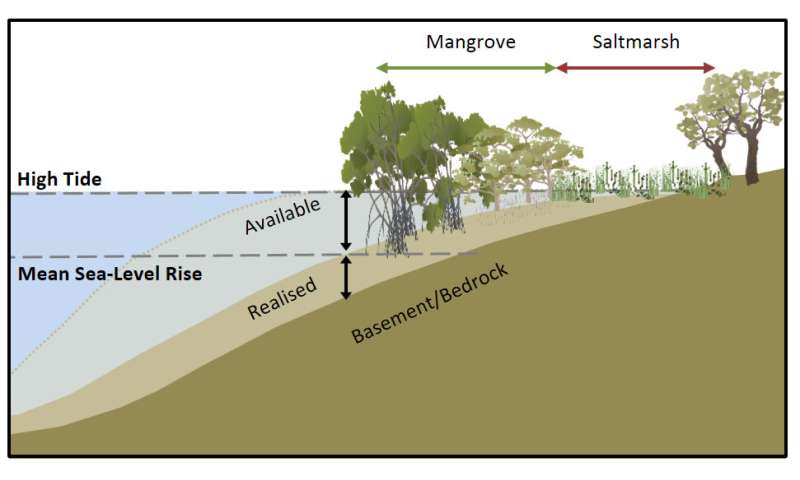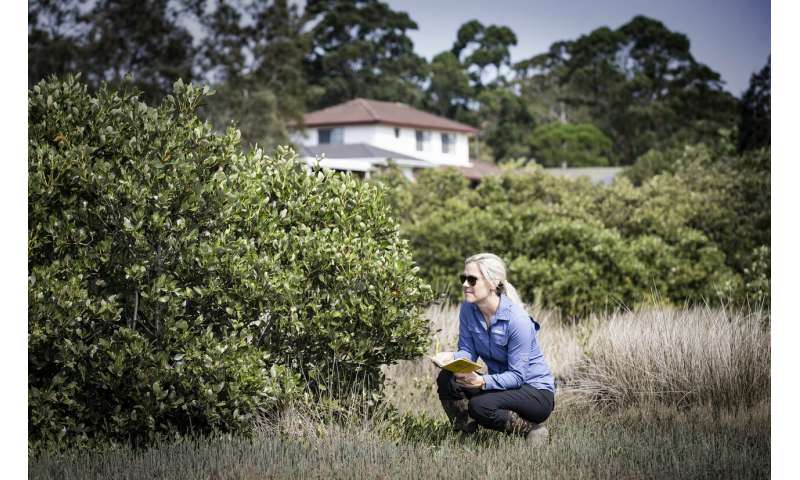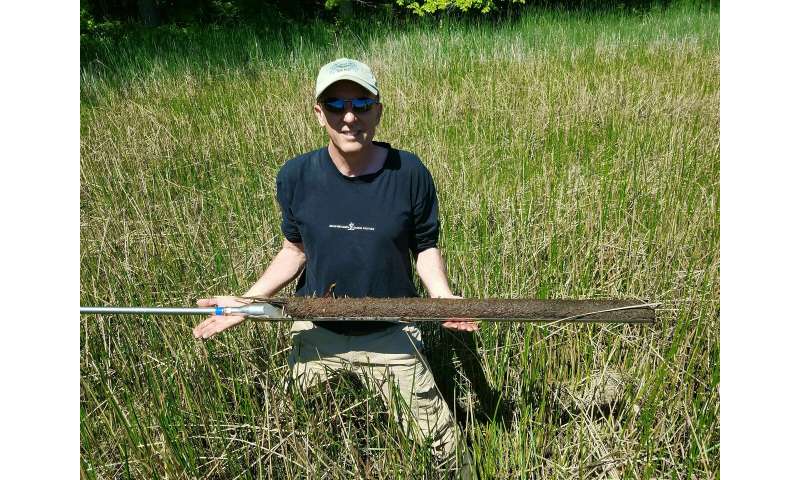Coastal wetlands capture more carbon as seas rise

New research shows tidal marshes could help mitigate the impact of climate change
As sea levels rise, coastal wetlands could play a key role in mitigating the effects of greenhouse gas emissions by capturing and storing large volumes of atmospheric carbon dioxide (CO2), research published in Nature has found.
Coastal wetlands (mangrove and saltmarsh) capture and store more CO2 per unit area than any other natural system. This is due to the high rate at which they generate biomass, and the saline, oxygen-depleted soils in which they grow, which are ideal for the burial and long-term storage of organic carbon.
The new research shows that these wetlands, termed "blue carbon" ecosystems because of their connection to the sea, become even more effective at sequestering CO2 as sea levels rise.
The research paper is the result of collaboration between researchers from the University of Wollongong (UOW), Australia; Macquarie University, Australia; Smithsonian Environmental Research Center, USA; Nelson Mandela University, South Africa; Yunnan University, China; and the Australian Nuclear Science and Technology Organisation.
Lead author Associate Professor Kerrylee Rogers, from UOW's School of Earth, Atmospheric and Life Sciences, said the research team analysed carbon stored in more than 300 saltmarshes across six continents, collecting data from the past 6000 years.
"Our paper shows that carbon storage by coastal wetlands is explicitly linked to sea-level rise," she said.

"Saltmarshes on coastlines subject to sea-level rise had, on average, two-to-four times more carbon in the top 20cm of sediment, and five-to-nine times more carbon in the lower 50-100cm of sediment, compared to saltmarshes on coastlines where sea level was more stable over the same period."
Sea-level rise leads to increased carbon sequestration due to what the researchers call "accommodation space" – the area available for a wetland to store mineral and organic sediments. In coastal wetlands, the boundaries of the accommodation space align with the upper half of the intertidal zone, roughly between the mean sea level and the high-tide level. As the sea level rises, so does the mean sea level and the high-tide mark, increasing the accommodation space in which carbon can be stored.
"Capture and storage of carbon by saltmarshes has a dual benefit. It removes CO2 from the atmosphere, mitigating greenhouse gas emissions, and the organic carbon that is accumulated builds the elevation of the wetland as sea levels rise," Professor Rogers said.
"Just like coral reefs, coastal wetlands can keep pace with low to moderate rates of sea-level rise, though are vulnerable to drowning under the high rates of sea-level rise projected by the Intergovernmental Panel on Climate Change."
The researchers compared carbon storage in saltmarshes in Europe and North America, which have experienced a consistent rise in relative sea levels over the past 6000 years, to those in the southern hemisphere, where relative sea levels have been comparatively stable. Those in Europe and North America have deep and highly organic sediments, while those on southern hemisphere coastlines have less organic carbon and a higher proportion of minerals in their sediments.
Co-author Dr. Patrick Megonigal, a Senior Scientist at the Smithsonian Environmental Research Center, said, "Scientists know a fair amount about the carbon stored in our local tidal wetlands, but we didn't have enough data to see global patterns. By synthesizing the local data, we discovered that soil carbon sequestration is linked to patterns of sea level rise at continental and global scales."
The researchers tested their hypothesis by analysing sediment from a saltmarsh at Lake Macquarie, NSW, where the removal of supports from an underground mine saw the shoreline subside by a metre in a matter of months in the 1980s. This rapid relative sea-level rise led to a fourfold increase in organic material in the sediment, much of it carbon.

Relative sea level refers to the position of the sea relative to land, as opposed to eustatic sea level, which refers to the volume of water within oceans. If land next to the sea rises or falls then the relative sea level will change even if the eustatic sea level remains the same.
The differences in relative sea level rises between the hemispheres over the past 6000 years is due to the melting of vast ice sheets that covered North America and Eurasia during the last glacial period and the resulting flexure of the Earth's mantle as the weight of the ice lifted. Continents in the southern hemisphere were less affected by ice sheet loads.
"Saltmarshes on the tectonically stable coastlines of Australia, China and South America may be the sleeping giants of global carbon sequestration," Professor Rogers said.
"Collectively, they contain half the global saltmarsh extent. A doubling of carbon sequestration in these wetlands would sequester an additional five million tonnes of atmospheric carbon per year, providing a mitigating feedback between sea-level rise and atmospheric carbon concentrations.
"However, this potential benefit is compromised by the ongoing clearance and reclamation of these wetlands. Preservation of coastal wetlands is critical if they are to play a role in sequestering carbon and mitigating climate change."
ABOUT THE RESEARCH
'Wetland carbon storage controlled by millennial-scale variation in relative sea-level rise', by Kerrylee Rogers, Jeffrey J Kelleway, Neil Saintilan, J Patrick Megonigal, Janine B Adams, James R Holmquist, Meng Lu, Lisa Schile-Beers, Atun Zawadzki, Debashish Mazumder, and Colin D Woodroffe is published in the 7 March issue of Nature.
The Australian Research Council, Australian Institute of Nuclear Science and Engineering, UOW Global Challenges Program, the National Science Foundation-funded Coastal Carbon Research Coordination Network, and the Smithsonian Institution supported the research.
More information:
‘Wetland carbon storage controlled by millennial-scale variation in relative sea-level rise’, by Kerrylee Rogers, Jeffrey J Kelleway, Neil Saintilan, J Patrick Megonigal, Janine B Adams, James R Holmquist, Meng Lu, Lisa Schile-Beers, Atun Zawadzki, Debashish Mazumder, and Colin D Woodroffe is published in the 7 March issue of Nature. doi.org/10.1038/s41586-019-0951-7
Provided by University of Wollongong